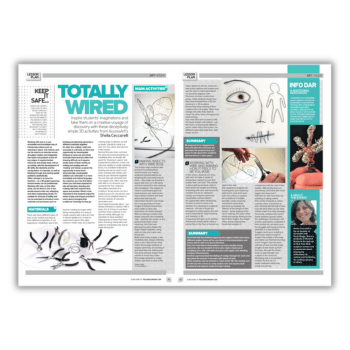Inspire students’ imaginations and take them on a creative voyage of discovery with these deceptively simple 3D wire art activities from AccessArt’s Sheila Ceccarelli…
Wire art is a very accessible and immediate way of introducing notions such as ‘drawing in space’ and volume.
It requires limited resources and simple tools. As an artistic activity it aids the development of 3D skills, like dexterity and the manipulation of materials.
Often, storage is an issue for teachers – so a 3D project spanning several weeks can be problematic. On the other hand, you can do wire art in one or two double lessons with very satisfying and often outstanding results.
Visual/spatial thinkers
Wire art is suitable for all levels of ability. You can extend it to introduce more materials and processes such as binding and attaching elements in different materials together.
It’s often the ‘unlikely’ child who succeeds in a 3D task, so this is the opportunity for visual/spatial thinkers to come out and shine!
Ironically these learners often find drawing difficult, as it requires similar parts of brain activity as writing and reading, not ‘making’ and ‘doing’.
Given the opportunity to draw three-dimensionally, visual/spatial children can ‘articulate’ in a more immediate and natural language. As a teacher, you may find talent where you had least expected it.
Like all exercises, wire art requires time, space and practice. What’s most important is that students enjoy the sense of play and inquiry and don’t worry about changing their sculptures/drawings as they go.
Sheila Ceccarelli is the co-founder of AccessArt. She is a graduate of Norwich School of Art and has an M.A. from RCA Sculpture School. Read advice for helping students with their GCSE art final piece.











